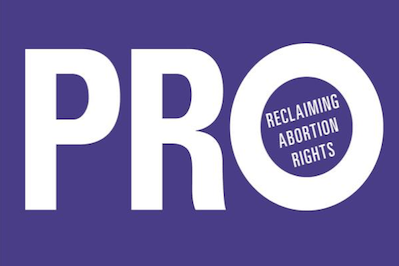Pro: Reclaiming Abortion Rights
What was lost during the endless battles over abortion, Katha Pollitt writes in her new book, was not only the right to abortion, but a larger feminist claim for sexual freedom, economic equality and social independence. Image by Picador
Image by Picador
Image by Picador
|
To see long excerpts from “Pro” at Google Books, click here. |
“Pro: Reclaiming Abortion Rights” A book by Katha Pollitt
I still remember the day in 1973 that the Supreme Court handed down Roe v. Wade, the decision that gave women the right to choose an abortion. I was thrilled that women would no longer risk their lives seeking illegal abortions. But I admit I felt anxious and ambivalent. The Supreme Court had acted before the nation had debated the issue. I feared that what the court gave, the court could take away. Still, it seemed like a miracle and I had seen no evidence that Congress had the political will to make abortion legal.
From that day on, opponents of abortion — which included Catholics, evangelicals and funders of right-wing politics — began organizing to repeal the court’s decision. By 1980, Republicans had turned abortion into a powerful wedge issue and for the first time inserted the repeal of the court’s decision into their party platform. Four years later, abortion became a litmus test for every national political candidate.
In her new book, “Pro: Reclaiming Abortion Rights,” Katha Pollitt — poet, essayist and columnist for The Nation magazine — reminds us of what life was like before Roe v. Wade and critically examines the abortion wars that followed in its wake.
“We tend to forget that both Democrats and Republicans once supported abortion,” Pollitt writes. “Of the seven Supreme Court justices who made up the majority in Roe, five were nominated by a Republican president.” Feminist activists spoke up about their abortions and most described relief, not tormented lives filled with regret. The original feminist demand for legal abortion promoted a broad vision of women gaining control of their bodies, including their sexual freedom, choosing when or whether they wanted to be a mother and ending the poverty that so often kept a woman from having a child. Abortion, even when illegal, was a common event in women’s lives.
It still is. “By menopause, 3 in 10 American women will have terminated at least one pregnancy, about half of all U.S. women who have an abortion have already had a prior abortion and 21 percent of pregnancies end in abortion. Contrary to the popular stereotype of abortion-seeking women as promiscuous teenagers, or child-hating professionals, around 6 in 10 women who have an abortion are already mothers. And 7 in 10 are poor or low-income.”
Pollitt reminds us that “abortion, in other words, is part of the fabric of American life, and yet it is arguably more stigmatized than it was when Roe was decided.”
Explaining why and how abortion became demonized is one reason she wrote “Pro.” Her goal is to address the “muddled middle,” those who may not be terribly concerned with abortion, and to encourage them, as well as activists, to reclaim feminists’ original sense of rights, without apology or shame.
Pollitt is an equal opportunity critic. Part of her book is a brilliant attack against the “pro-life” movement and the strategic war it has waged against women and abortion. At the same time, she offers a frank and critical appraisal of the abortion rights movement and what it might have done differently.
In Pollitt’s view, the opponents were so successful because they changed the terms of public debate, just as they eliminated the estate tax by cleverly recasting it as a “death tax.”How did they do this? They insisted that “personhood” begins at the moment of conception, granted the fetus the rights of an individual, demonized women who had abortions as selfish murderers, and deceptively promoted the belief that abortion caused cancer and/or a lifelong debilitating depression. They also portrayed women who sought an abortion as cold and selfish. Most effectively, opponents created the impression that rare late-term abortions (1.5 percent), rather than 12-week procedures (88 percent), represented the typical termination of a pregnancy. “We may roll our eyes,” Pollitt writes, “when abortion opponents contrast the anguish of abortion with the joys of unwanted babies, and the selfishness of women who end their pregnancies with the nobility of women who keep theirs whatever the difficulty, but over time it seeps in.”
The result is that “[o]nly twenty-three states could be said to have a strong commitment to abortion rights,” and “[a]s of 2013, only one state, Oregon, has added no restrictions to the original Roe decision.”
“What this means,” Pollitt explains, “is that although abortion has been legal for four full decades, for many women in America it might as well not be. It is inaccessible — too far away, too expensive to pay for out of pocket, and too encumbered by restrictions and regulations and humiliations, many of which might not seem to be one of those ‘undue burdens’ the Supreme Court has ruled are impermissible curbs on a woman’s ability to terminate a pregnancy, but which, taken together, do place abortion out of reach.”
Could the abortion rights movement have been more effective? Although Pollitt clearly understands the polarized political zeitgeist in which the abortion wars have been fought, she still criticizes supporters for being too timid. President Bill Clinton, for example, sought to appease opponents by declaring that abortion should be “safe, legal and rare,” a phrase that reinforced a negative view of the procedure.
All too often, she argues, abortion rights activists squandered opportunities to explain the actual reasons women seek abortion. Nor did they fight hard enough for federal funding for abortions, which often made abortions inaccessible to poor women. None of the national organizations ever deployed an adequate language for women’s right to have an abortion. “Pro choice” was lame. “[I]n 2013,” she notes, “Planned Parenthood announced that it was moving away from the term ‘pro-choice,’ which was itself a bit of a euphemism: choose what? In mass-media messaging you’re likely to hear about ‘defending Roe,’ even though only 62 percent of Americans (and only 44 percent of those under thirty) know what Roe is.” In Pollitt’s view the abortion rights activists should have reframed the movement’s goal as one of reproductive justice, which would have addressed the needs of poor and minority women.
“Pro” is a wake-up call to all those women (and men) who think they need not concern themselves with abortion. Opponents are winning the battles. They are everywhere, threaded throughout conservative political culture. Feminists for Life, for example, is an organization that travels around the country encouraging pregnant college-aged women to be single mothers. In 1994, I sat in a huge auditorium and watched its leader, Serrin Foster, encourage young women not to have an abortion. When I later asked her who would help this young single mother, she suddenly canceled our interview. Pollitt also notes how Feminists for Life uses its “cheery handbook” to turn an unwanted pregnancy into a brave, exciting, feminist choice.
In a chapter cleverly titled “What Do Abortion Opponents Really Oppose? (Hint: It’s Not Just Abortion),” Pollitt quite accurately explains that abortion symbolizes the historic rupture between sexuality and reproduction, and women’s new sexual freedom. “You’d think opponents would support greater contraception so that there would be fewer abortions. But the real demon is the woman who chooses to exercise her sexual freedom. As a result, opponents have opposed contraception in the Affordable Care Act, as well as sex education. Abstinence is their solution to women’s new sexual independence from men.”
Aside from women’s sexuality, Pollitt brilliantly demonstrates how opponents’ views are linked to “anti-feminism, the shaming of sexually active girls and single women, fears of white demographic decline, and conservative views of marriage and sexuality or outright misogyny.” The opposition, in short, is well organized at both the national and local level and publicizes a long list of dangers “associated” with abortion. At the local level, abortion rights organizations, on the other hand, are relatively invisible and largely focused on defending one Supreme Court decision.
Could the abortion rights movement have retained its original feminist vision? Could it have swayed public opinion and changed the terms of debate? I don’t think so, even though I share Pollitt’s critique and her sense of loss of a more radical vision of women’s freedoms.
For those who supported abortion, Roe already seemed a significant victory. The members of the opposition, however, felt threatened by changing gender relations and women’s sexual freedom. They also dived into local politics and community life, whereas supporters largely relied on national organizations and massive marches in the nation’s capital. The backlash against the women’s movement and the poor, moreover, limited efforts made by progressive activists. The truth is, as Pollitt points out, opponents were more motivated and supporters were too complacent.
I’m not sure how many of the “muddled middle” will read a book that so unequivocally supports women’s independence and so elegantly argues that the relentless assault on abortion reflects an almost existential fear of women’s sexual freedom. What was lost during these endless battles over abortion was not only the right to have an abortion, but a larger feminist claim for sexual freedom, economic equality and social independence — a radical vision that was never accepted even by most supporters of abortion.
Still, Pollitt’s wonderfully accessible book keeps the dream alive. Her conversational style helps the reader grasp her dazzling dissections of right-wing politics. She is a passionate and inclusive feminist who has always sided with those who fight for their rights, and with women who seek an abortion because they cannot afford to care for a child.
For those who have somehow ignored the endless abortion wars, Pollitt’s book just may remind them that the right to have an abortion has already disappeared in vast regions of the country. Ultimately, her important, well-researched and fascinating book asks, “Do you care?”
Your support matters…Independent journalism is under threat and overshadowed by heavily funded mainstream media.
You can help level the playing field. Become a member.
Your tax-deductible contribution keeps us digging beneath the headlines to give you thought-provoking, investigative reporting and analysis that unearths what's really happening- without compromise.
Give today to support our courageous, independent journalists.






You need to be a supporter to comment.
There are currently no responses to this article.
Be the first to respond.